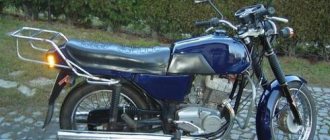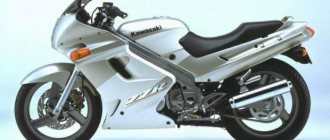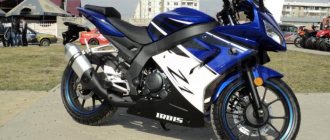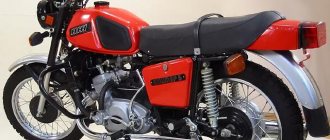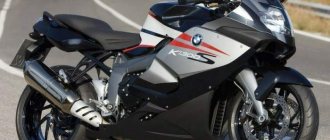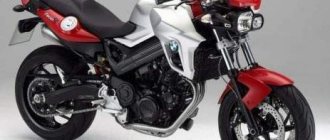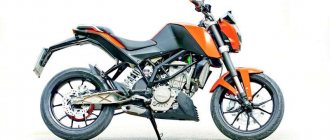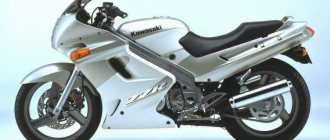Russian motorcyclesIZH motorcycles
Domestic motorcycle production was not particularly diverse.
The same manufacturer, which produces middle-class motorcycles, simply copied its models from generation to generation, only bothering to adjust the appearance and make minor changes to the technical part, but the concept of the motorcycle itself remained unchanged.
Only relatively recently did IZH designers decide to create something different from their main models.
This decision resulted in the appearance of such a model as the IZH Junker, whose factory marking is IZH 6.113-020-5.
Appearance
The desire of manufacturers to make something special, unlike previous versions, led to the emergence of the IZH “Junker” bike. It can be considered one of the most remarkable examples.
The external design is reminiscent of American motorcycles. This is emphasized by a high curved steering wheel, a drop-shaped fuel tank, a low driver's seat, as well as chrome elements, which are present in abundance.
The motorcycle frame remains tubular with welded seams. The geometry was slightly changed to lower the saddle. Wiring traditionally runs along the frame. She hides under the fuel tank.
It should be noted that the tank is not solid, but consists of two halves. Each of these compartments holds 7.5 liters of fuel. Moreover, each part is equipped with its own faucet, lid and filter. And, of course, you need to refuel each one separately. Why this was done is unclear. Between the parts of the tank in front are the speedometer and windows for warning lights. These elements also remained unchanged. A small round headlight is located in front.
Unlike previous models of Izhevsk motorcycles, the IZH “Yunker” has a footrest located in the center of the frame, and not closer to the end. You need to get used to this arrangement. The driver's footrests are moved forward. This is done to improve the fit.
The seat is designed for two people. For the driver, the part is omitted. But the passenger seat is located a little higher. It has a backrest that comes with the bike. The rear light is attached to it on the reverse side.
“Verkhovyna-5” (LMZ-2.153)
It was produced since 1974 and featured a greatly modified appearance. The moped received a horizontal tank with a capacity of 7 liters, a different trunk, and a new front fork. The Sh-57 engine was installed on the moped.
In 1978, they began producing Verkhovyna-6 (LMZ-2.158) with a slightly modified design and a Sh-57 engine, and later a Sh-58 with a kickstarter.
In addition to the base model, production of “Verkhovyna-6-Sport” and “Verkhovyna-6-Tourist” was also launched. “Verkhovyna-6-Sport” was distinguished by a top-mounted muffler, a cross-type steering wheel with a jumper and a sprung front wheel guard. “Verkhovyna-6-Tourist” had a wind deflector and two spacious luggage bags behind the driver’s saddle.
One of the “Verkhovyna-6” became the two-millionth moped (!) of the Lviv Motor Plant. “Verkhovyna-7” (LMZ-2.159) - the last of the “Verkhovyna” - was produced since April 1981. The moped was equipped with a new front fork, new, more powerful lighting equipment and a new trunk.
Verkhovyna-7 was equipped with derated Sh-62(M), and later with V-50. The maximum design speed of the moped was reduced to 40 km/h.
In the spring of 1981, a model no less significant for the history of the Lviv Motor Plant appeared - the Karpaty mokik (LMZ-2.160),
0 and in 1986 the mokik “Karpaty-2” (LMZ-2.161) was released. Both Karpaty mokiks, in the development of which the VNIITE branch in Leningrad took part, were equipped with a Sh-58 or Sh-62 engine with a contactless ignition system.
If we talk about the external differences between the “Verkhovyna-7” and “Karpaty” mopeds, the most obvious is the changed shape of the frame, tank, muffler and side casings in the “Karpaty” mopeds. The developers increased the service life of the new model: the warranty mileage of the Karpaty mokik was 8,000 km (Verkhovyna-7 had 6,000), and the service life before the first overhaul was up to 18,000 km compared to 15,000 km for Verkhovyna. Like “Verkhovyna-6”, the mokick “Karpaty” also had similar modifications - the “Karpaty-Tourist” moped and the “Karpaty-Sport” youth moped. Subsequently, the Karpaty-2-Lux moped was also produced, the distinctive feature of which was direction indicators.
In 1988, the Lviv Motorcycle Plant produced 123 thousand mopeds. Once the production volumes of this plant were twice as large, however, in the second half of the 80s it was necessary to reduce the production of 50 cc cars due to a drop in demand and actively develop new models to attract buyers. A new model LMZ-2.164 was developed. In 1990, the Serpukhov Scientific Research Institute of Motorcycle Engineering designed a new modern model of the D-51 engine with a petal valve at the inlet and an automatic centrifugal clutch, which was supposed to be installed on new models of Lviv mopeds, but the engine did not go into production...
It is curious that, having overtaken the companies of Germany and France, which laid the foundation for the mass production of small motor vehicles, by the early 80s of the 20th century we took third place in the world (after Japan and Italy) in the production of mopeds and began to supply them to the foreign market (for example, in Hungary, Poland, Angola, Bangladesh, Cuba and even Italy). (M. Leonov, What should a youth moped be like?, “Technology for Youth”, No. 3, 1983, p. 48).
IZH "Yunker": technical characteristics
In addition to the external design, manufacturers also paid attention to the technical side of the motorcycle. In this area, Junker is very similar to other enterprise models. But it also has its own characteristics.
The bike is controlled according to a standard scheme. Handles were attached to the steering wheel. The right one is responsible for the front brake. There are also two buttons here: “Engine Stop” and “Light / High Beam”. The rear brake and clutch were placed on the left side.
The similarity of characteristics of the IZH Jupiter-5 and IZH Junker motorcycles is obvious. Their spare parts are interchangeable. This makes it easier to find the right parts during repairs. The motorcycle is suitable for off-road riding. But manufacturers do not recommend doing this.
The power unit is two-stroke two-cylinder. In front of them, a radiator for water cooling is mounted on the frame. It is protected from damage by arches located on both sides. To start the engine there is a kick starter located on the left side. It is operated by the foot. The company's developers were unable to come up with a starter for this model of motorcycle. Each cylinder has a separate exhaust pipe. They are located on the sides. In addition to the functional one, they also have an aesthetic function. The exhaust pipes look like chrome elements.
Mechanical type gearbox. Has four positions. It works in conjunction with a chain drive located on the right side.
Motorcycles "Java"
Another legendary Jawa motorcycle dates back to 1929. This brand of road transport belonged to a Czechoslovak company and was the dream of many Soviet motorcycle enthusiasts. Motorcycles were used not only for everyday travel, but also participated in various racing competitions. In the 21st century, the production of Java has not stopped; some models are still in demand.
Jawa 350 Classic
The motorcycle is based on a 2-cylinder, 2-stroke system with a 4-speed gearbox. There is no connection between gasoline and oil thanks to a separate lubrication system. The motorcycle frame is strong, which allows you to load motor vehicles up to 200 kg. It is possible to attach a car seat.
If we compare the Jawa 350 Classic 638 model with others, more expensive and equipped, it wins in several respects: maintenance is simple and inexpensive, fuel consumption is low, spare parts are available for sale at a low price.
Technical characteristics of "Java" 350 classic:
- dimensions – 2110×750×1070;
- engine capacity - 343.5 cubic meters. cm;
- power – 23.1 l. With.;
- maximum speed – 125 km/h;
- gasoline consumption per 100 km – 4 liters;
- manual gearbox.
Jawa 350 Classic Sport
“Classic Sport” is an improved version of Jаwa 350 Classic. It was presented in 2015 at the Moscow exhibition “Motopark”. You can distinguish the model from other Java motorcycles by the “outdated” design of London in the 60s, when street motorcycle racers converted inconvenient and bulky motorcycles for themselves, removing everything unnecessary. The two-wheeled vehicle turned out to be light and maneuverable, with streamlined elements.
Jawa 350 Classic Sport is designed for solo travel and is equipped with one comfortable seat. The low steering wheel allows you to comfortably take the position of the rider, fully concentrating on the ride. The “rarity” of the motorcycle is reminiscent of its classic elements: a wide chrome exhaust pipe, a round headlight and a traditional red body color.
The motorcycle has a lot of advantages that make for a comfortable and maneuverable ride: a 343 cc engine, a separate lubrication system, a reliable disc-type brake system, a laconic dashboard and an automatic starter.
Specifications:
- engine capacity – 343.5 cubic meters;
- number of cylinders – 2;
- number of cycles – 2;
- power – 23 l. With.;
- maximum acceleration speed – 125 km/h;
- gasoline consumption per 100 km – 4 liters;
- air cooling system.
Jawa 350 Lux
The presented model is a classic version of a street class road motorcycle. It combines elements of older models, but also has individual modern features. The front of the motorcycle has a classic single headlight, and the electronic instrument panel is simple and understandable even for novice motorcyclists.
The basis of the two-wheeled design is a strong steel alloy frame. Its rigidity improves maneuverability on uneven roads, makes the vehicle maneuverable and increases load capacity. The holistic appearance of the Java 350 Lux clearly resembles a “classic”.
Specifications:
- dimensions – 2110×750×1070 mm;
- engine capacity – 343 cubic meters. cm;
- number of cycles – 2;
- number of cylinders – 2;
- power – 23.1 l. With.;
- maximum speed – 125 km/h;
- Fuel consumption per 100 km is 4 liters.
Jawa 660 Sportard
The most powerful Java model in terms of technical equipment is the 660 Sportard. The engine capacity of 600 cubic meters affects the ability to reach speeds of up to 250 km/h. The motorcycle covers distances along the highway easily and maneuverably. For beginner motorbikers, this is an excellent tool - flexible and playful. And externally, the 660 Sportard looks more aggressive and modern than the classic versions.
The technical characteristics have their own characteristics: the power plant is “single-barrel”, equipped with an electronic injection system - EFI
The frame frame has a high degree of rigidity, and this is an important condition for off-road driving - the motorcycle does not twitch and is easy to control. The upgraded suspension of the bike allows you to take turns at the same speed without pressing the brake pedal
The technical specifications are as follows:
- dimensions – 2100×760×1250 mm;
- cylinders – 1;
- number of measures – 4;
- engine capacity – 651.9 cubic meters. cm;
- power – 48 l. With.;
- gas tank volume – 17 liters;
- Manual transmission – 5-speed.
Suspension
The front suspension of the IZH "Junker" motorcycle is represented by a telescopic fork. The latter operates using a hydropneumatic telescopic fork. It gives the movement smoothness.
The rear suspension remains the same. It is represented by a pendulum with two shock absorbers. The difference is that they are located not exactly, but at an angle.
The beginning of the way
Until 1999, it was difficult to believe in the popularity of the IZH concern. The Junker motorcycle smashed this stereotype to smithereens.
And there is a reason for it. In the distant nineties, it was impossible to find a “normal bike” on any road (of course, by today’s standards). Then self-propelled iron “boxes” with strollers, called “vehicles,” drove around. And IZH “Junker” hastily burst into this “paradise for designers”. The characteristics are top notch, the design too, and most importantly, an innovative and hitherto uncreated American style. For the first time, a good motorcycle appeared on bad roads. Moreover, it is comfortable to sit on, easy to care for and soft to ride.
Power unit
All models of recent years that rolled off the plant's assembly line were equipped with U6 engines. Including IZH "Junker". Its characteristics are known to all lovers of domestic motorcycles. This is a two-stroke engine with two cylinders. Its working volume is only 347 cubic centimeters. It produces 24 horsepower. The frequency indicated in the passport exceeds that indicated by the engine during operation. The theoretical value is 6 thousand revolutions per minute. In practice, this value does not exceed 5 thousand revolutions per minute.
The engine is gasoline. But a certain amount of oil must be added to gasoline. This is necessary in order to lubricate the engine.
The maximum speed of the IZH Junker motorcycle is 115 kilometers. At a speed of 60 kilometers per hour, fuel consumption is 4 liters. As speed increases, fuel consumption also increases. When driving 90 kilometers per hour, fuel consumption increases to 5.7 liters. These indicators are typical for driving on the highway. As for moving around the city, the approximate consumption does not exceed 7 liters per 100 kilometers.
Photo gallery
Izh Junker is a recreational motorcycle that you have most likely encountered more than once, but you would not even suspect that this motorcycle came out of the assembly line of the Izhevsk plant. It’s not for nothing that it is considered one of the most beautiful models of domestic production. Let's look at it in our selection.
Test Drive
The tests carried out show good results. The IZH Junker motorcycle is easy to control. It handles turns well. But it is not very fast. According to technical documents, this figure is 115 kilometers per hour. But during real trips, the motorcycle can accelerate to 120 kilometers per hour.
The engine produces 24 horsepower at 6 thousand rpm.
Estimated cost
Production of IZH Junker has stopped , and it will no longer be possible to purchase a new motorcycle.
But for those who still want to own a motorcycle that is so non-trivial for our motorcycle industry, help can be provided by the secondary market, where it is still found, and the cost of this unit is not at all high and ranges from 30 to 90 thousand rubles.
At one time, this motorcycle was awarded the State Quality Mark - IZH Jupiter 3, the technical characteristics of which ensured reliability.
The design of this IZH motorcycle is made in a classic style and differs little from the appearance of its contemporaries.
M-1A "Moscow"
Let's try to build this excursion into the motorcycle past of a great country in chronological order. Let's take the post-war period, well, simply because it is clearer and closer to us.
The motorcycle industry was revived on the basis of the best examples of captured equipment. And a lot of it was brought to the USSR. And now at the Moscow Bicycle Plant they are mastering the production of a copy of the German motorcycle DKW RT125 with a 125 cc engine.
The device is called M-1A “Moscow”. This is the first post-war motorcycle of the USSR - simple and lightweight, which did not require a lot of metal and rubber.
Motorcyclists were trained on this type of equipment in DOSAAF schools. In 1951, production was transferred to Minsk to a newly built bicycle plant. Almost the same model with the index K-125 was produced in Kovrov.
Motorcycles "Minsk"
Motorcycles of the Belarusian brand "Minsk" began to be produced in 1951, and in 2007 the manufacturing plant became private from a state-owned one.
Minsk D4 125
This model is simple and economical, but at the same time fully adapted to the roads of Russia and the CIS countries. The modern design fits perfectly into the traffic flow of the vehicle. The motorcycle is light and maneuverable, with good and smooth shock absorption.
The vehicle has a 125 cc engine. cm and a capacity of 10.2 liters. With. The built-in electric starter responds instantly to starting. The external design is individual. Dimensions – 2100x1110x770 mm.
Minsk S4 125
Minsk C4 125 was released in 2008. Light in both weight and control, maneuverable, inexpensive - this transport is chosen by young people and summer residents. It makes a good first bike for new riders, although its understated appearance may put some off at first glance.
The C4 125 model has a number of advantages:
- low cost;
- low fuel consumption;
- small dimensions and weight;
- adaptation to temperature changes.
There are also disadvantages:
- fastenings are unreliable;
- small mirrors contribute to poor visibility;
- The included tool kit does not fit the motorcycle;
- the electric engine start button is located at an inconvenient level;
- small fairing.
Minsk TRX 300i (tour-enduro)
The Minsk TRX 300i, which is more modern in design, attracts attention with its bright and sporty appearance. It embodies the enduro qualities of European manufacturers, which significantly distinguishes it from its Belarusian compatriots
This motorcycle is designed for long trips on a variety of road surfaces.
The 4-stroke engine is started using an electric starter. Movement is carried out by a 6-speed manual transmission. The transport is designed to transport 2 people.
Characteristics:
- dimensions – 2080/825/1230 mm;
- weight – 155 kg;
- front suspension – telescopic fork;
- rear suspension - mono shock absorber.
MINSK RX 250 (cross)
The cross-country “Belarus” is the latest development of the Minsk manufacturer. A special feature of the motorcycle is that it is assembled from parts from leading companies:
- Domino controls;
- Acerbis plastic;
- Leo Vince muffler;
- Dell'Orto carburetor;
- professional Fast Ace suspension;
- DID circuit
The wheels are equipped with aluminum rims with spokes made of durable metal alloys. The RX 250's exterior is bold and sporty. The model attracted the interest of avid crossers, so in the 2011-2012 season the motorcycle took part in the “Belarusian Motocross Championship” and proved itself to be a reliable and serious racer.
In 1958, the Kharkov bicycle factory began producing the B-901 bicycle specifically for the D-4 engine.
Compared to a regular road machine, this bike had a shock absorber in the front fork and larger tires. Apparently, the B-901 can be considered the first Soviet mass-produced motorbike. Then the production of motorbikes was transferred to the Lvov Metal Plant (since 1960, Lviv Motorcycle Plant - LMZ). In the same year, the plant began producing B-902 motorbikes, which differed from the B-901 mainly in the frame design.
In 1962, the plant’s design bureau created the MV-042 “Lvovyanka” motorbike. It was a fundamentally new model with a special load-bearing all-stamped frame, telescopic front fork and even spring-loaded rear suspension.
In the first batches of the Lvovyanka, the engine was still the same - D-4. In the process of subsequent modernization of the moped, instead of a rear fork with a central spring, they began to install double shock absorbers in aluminum casings. And, most importantly, the D-4 was replaced by a new engine - the D-5, with the compression ratio increased to 6 units. Engine power increased to 1.2 hp. at 4500 rpm, fuel consumption remained at 1.5 l/100km.
The high thermal stress of the D-5 forced the designers to use a new cylinder with developed ribs and a removable head.
The “Lvovyanka” was replaced by the light moped “MV-044”, characterized by a developed hood and angular shapes.
In 1969, they began to produce a new model - “MP-045” with a reinforced frame and a larger gas tank.
The last of the light mopeds produced by the Lviv Motorcycle Plant is “MP-047” “Tisa”. After this model, the plant completely switched to the production of heavy mopeds - “Verkhovyna”, and subsequently “Karpaty”.
It should be noted that rear shock absorbers were installed on all light mopeds of the Lvov plant. Light mopeds from other Soviet factories, as well as most foreign light mopeds of those years, did not have such “luxury”.
Almost simultaneously with the plant in Lvov, the production of light mopeds was launched at the Riga motorcycle plant “Sarkana Zvaigzne” (“Red Star”) and at the Penza Bicycle Plant named after M.V. Frunze.
The running gear of the first light moped, the production of which began in Riga in 1959, was the Riga-16 men's bicycle manufactured here.
The familiar D-4 engine was installed on the bike. (A. Popov, Cooled Star, “Moto”, No. 1, 2012, p. 88). The resulting design was very reminiscent of the B-901 motorbike from the Kharkov bicycle factory.
"Minsk M1A". First Belarusian
To this day, the “Minskachi” remains the most “popular” motorcycle in Belarus. They run along the roads of the entire former Union, and not only. But most of them, of course, are in their homeland.
Minsk motorcycles passed their half-century anniversary a long time ago (the first models already fully deserve the name “vintage”), and very soon, on July 12, they will celebrate their 61st birthday.
The first Belarusian “bike” was the Minsk M1A, which had many “relatives” not only in the USSR, but also abroad. The “ancestor” of the motorcycle was developed in 1939 by the Germans. The DKW RT125 turned out to be so successful that analogues of this motorcycle were produced under different names in 7 countries around the world, including the USA, England and Japan.
By the way, one of the old “Minsk racers” was tested in harsh conditions by one of the hosts of the famous British show Top Gear, Richard Hammond. He drove it from south to north almost all of Vietnam. CV of the charismatic “car maniac”: “This is the AK-47 among motorcycles - reliable, simple, easy to repair. It was made specifically for those countries where there are no roads.”
Repair and tuning
Both the IZH Planet 5 engine, the transmission, and its chassis are truly distinguished by their high maintainability. If the bike you received has spent many years in caring hands, there will most likely be no problems with it, especially if it is serviced on time. But for careless owners, Soviet motorcycles quickly break down.
Repair
Most often minor damage occurs. The ignition fails, the electrics begin to take on a life of their own, the speedometer cable breaks, the light bulbs in the headlights and turn signals burn out. The main components are distinguished by good reliability, even the engine, despite the fact that 2-stroke engines cannot boast of a significant resource.
Spare parts
Despite the fact that this model was discontinued a long time ago, spare parts for the IZH Planet 5 motorcycle are still not difficult to find. The easiest way is to look for the necessary hardware at flea markets and on the Internet, since Avito always has plenty of offers. Prices depend on the greed of a particular seller, but in general everything is cheap.
Tuning
Since the vast majority of IZH Planet 5 units that are still running live in rural areas, their tuning is usually unique. Most often it comes down to buying all sorts of lights and stickers on Aliexpress and then turning the unfortunate motorcycle into who knows what. Adding horsepower to an engine is the dream of every first-time “tuner,” but to do this, it’s easier to change the bike itself. There are, of course, craftsmen who manually forge new valves and bore piston valves, but this is the case when the game is not worth the candle.
Mass production
Serial production at the motor plant (Izh-7, Izh-8, Izh-9, Izh-12) in the period 1933-1941.
By the early 1930s, motorcycles were not being manufactured. Despite this, separate initiative groups of enthusiasts in Moscow, Leningrad, Kharkov, including P.V. Mozharov in Izhevsk, worked on the creation of a domestic motorcycle. A commission of experts of the Presidium of the Supreme Economic Council of the USSR considered the issue of building a large motorcycle plant and came to the conclusion that the most suitable place for its location would be Izhevsk. The city had a full range of engineering production - from steel smelting to the manufacture of complex tools and machine tools, the workers had the necessary qualifications, and there were no difficulties in the supply of raw materials. Here, on the basis of the hunting rifle factory of the manufacturer Berezin, located on Bazarnaya Street, the construction of the Experimental Motorcycle Plant began.
At first, they planned to produce the heavy motorcycle “NATI-A-750” at this plant, designed under the leadership of P.V. Mozharov. The motorcycle had a two-cylinder V-shaped engine with a displacement of 747 cubic cm, a stamped frame characteristic of Mozharov motorcycles, and reached a power of 15 hp. By May 1, 1933, the first 4 motorcycles were manufactured. At the same time, prototypes of the Izh-7 light motorcycles were assembled according to documentation received from Leningrad. In fact, these were twins of the L-300 model (the same copy of the DKV-Luxus-300 developed by Mozharov) - a two-stroke single-cylinder engine with transverse blowing, a three-speed gearbox, a chain drive to the rear wheel, a frame made of stamped elements assembled on bolts, parallelogram front fork, unsprung rear wheel. But the Izh-7 underwent the sadly familiar operation of “reducing labor intensity”: the trunk and front flaps disappeared, the flat footboards were replaced with round ones, the rotating throttle handle was replaced by a rotary shifter, the decompressor drive was not remote, but by a tap on the cylinder head.
In the end, it was the Izh-7 that was chosen for serial production. True, of the 12 motorcycles manufactured in 1933, almost all returned to the factory - the ignition system failed. But soon the “childhood illnesses” were overcome, and in 1934 the plant produced 111 motorcycles.
At the beginning of 1938, the Izh-7 was replaced by a new model, the Izh-8. The 300 cc engine received a loop scavenging with two scavenging channels, due to which the power increased from 5.5 to 8 hp. The electrical system has also become more advanced - instead of a flywheel magneto, the car is now equipped with a generator and a battery. And in 1940, production of the Izh-9 model began, with its capacity increased to 9 liters. With. power. At the same time, documentation was received from Leningrad for the L-8 motorcycle, equipped with a 4-stroke overhead valve engine with a displacement of 348 cm³ and a maximum power of 13.5 hp. To speed up the development of the new model, it was decided to use the chassis of the Izh-9 motorcycle. Serial production of the new motorcycle, designated “Izh-12,” was supposed to begin in the summer of 1941. However, the further development of motorcycle manufacturing at the plant was prevented by the war.

